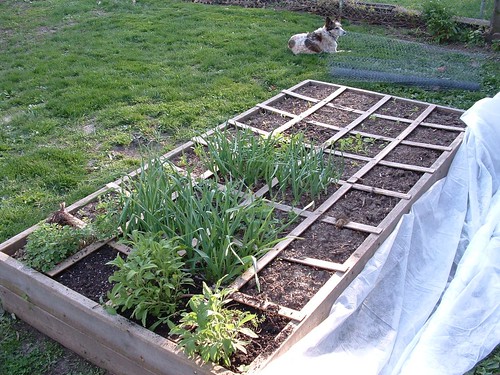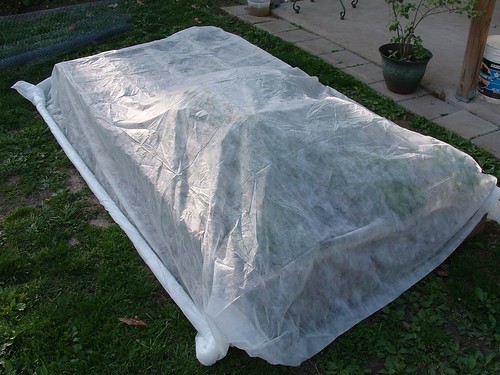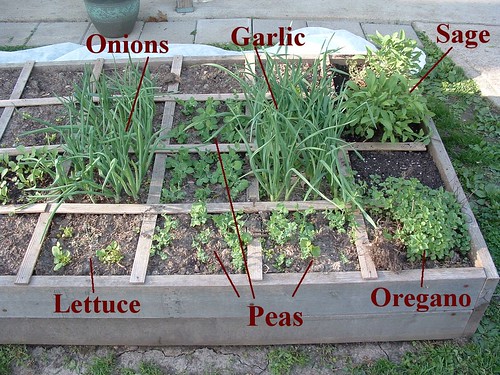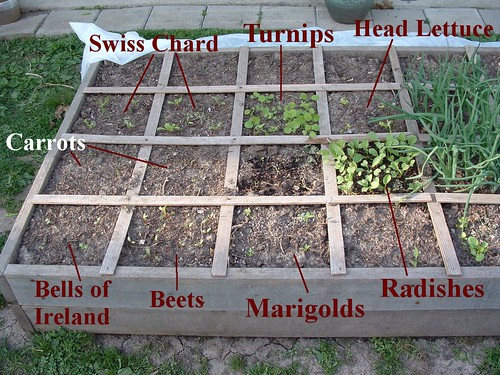Gardening Begins
[Before I get to the post, a little blog housekeeping: I just changed my settings so that once you've had a comment approved, all your future comments will be approved automatically. That way regulars won't have to wait two days for me to get around to checking them, especially on weekends. Now back to the show.]
Gardening actually began a few weeks ago, but this is my first report on it this year. We’re trying something new this year, called Square Foot Gardening, where you physically divide your garden up into one-foot-square sections and plant them each individually. I’d tinkered with the idea before, but I tried to do it halfway, dividing the spots by measuring them instead of building a physical grid. That doesn’t work very well, because a square foot seems like a bigger area than it really is when you’re planting tiny seeds, and when things grow, they’re way too crowded. So this time we’re doing it by the book, building the actual grid and planting what it says a square foot can support.
I didn’t take pictures of the building process, but it’s fairly simple. I got a bunch of 4-foot plaster laths (they come in bundles of 25) and some common 10-penny nails and some small finishing nails. I stacked up 6 laths, and drilled 3 holes a foot apart starting a foot from one end, big enough for the nails to go through. Arrange these laths in a tic-tac-toe shape and drop nails through the holes, and you’ve got a grid for a 4′x4′ raised bed. Since our raised beds are 4′x8′, I made two grids for each one, and then added one extra lath down the middle between them. I tacked down a few laths in each grid and the lone middle one to the frame of the bed with finishing nails (they’re small enough not to split the ends of the laths too much). The result looks like this (minus the tray of seedlings and the bird decorations):
Then in each square, you plant what a square foot can handle: 16 radishes, 9 peas, 1 tomato, etc. It’s assumed that you’ll provide a trellis for anything that will climb or can be tied up, so it should make for high production without crowding things more than they can handle. Here’s the other bed, with some perennials still growing from last year and some new things getting started:
The white stuff on the right is a floating row cover. We were having problems with sparrows picking leaves off the peas, and if the chickens ever get out they make a beeline for these beds to scratch for worms, so I got a floating row cover for it. It’s a very lightweight material that lets enough light and moisture through for things to grow, but keeps bugs and birds out. It also helps prevent wind and sun damage, if you’re setting out plants that need to be broken in slowly.
I tacked it along the north (right) side with ordinary tacks, then wrapped the other side around an 8-foot 1″x2″ board, and tacked it to that. So I can lift the board to easily cover or uncover it. Covered, it looks like this:
You can see the board wrapped up on the left. So far it’s working great, though I did have to explain to Pepper that I wasn’t making a soft place for her to lie in the sun. Here are some pictures of what’s growing so far in that bed (as of a couple weeks ago; more current pictures to come this week):
The garlic was planted last fall, and the sage and oregano on the right are perennials. There’s also a thyme plant in the square behind the sage, but the sage is hiding it. Everything else was planted early this year. You can kind of see how the nearest peas were being shredded by birds.
Some of this stuff is too small to see very well, but it’s there. The Bells of Ireland are a flower we grew a lot when we were kids, because they look cool. There were also parsnips and another type of lettuce, but they were old seed and didn’t come up, so those squares are getting re-seeded with something else. The far row of squares will be tomatoes tied to a fence along that side.
That’s it so far. I’ll post more pictures later this week, and maybe some from our community garden spot too, where potatoes are just starting to come up.
If you enjoyed this article, why not rate it and share it with your friends on Twitter, Facebook, or StumbleUpon?
loading...





